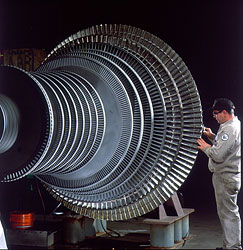
Born of the Atomic Age, the atomic energy that the car was run on promised clean, safe electricity that would be "too cheap to meter". At the rear of the car is the power capsule which of course held the reactor. The power capsule, which was expected to go for 5,000 miles, would be replaceable, easily swapped at the full-service recharging stations that were expected to replace gas stations. Without the need of a hood to house the engine, the passenger compartment was farther forward, to keep the passengers safely away from the radiation of the reactor. Though the technology was not yet available at the time (hence the concept part), it was expected that further technological development would shrink the reactor to the necessary size, along with the shielding that would be needing.
Okay, yes, I know what you, dear reader, are thinking right now and I share your thoughts that this is a bad idea! Just so that we're sharing the same thoughts, I'll list my concerns about this concept, with the gut reaction being last.
1) You can't get efficient nuclear power at this scale. Nuclear power works by using the energy of a nuclear fission reaction to produce heat to boil water into steam. The steam is sent across a rotor, which causes the rotor to spin which spins an attached shaft which goes to an electric generator. Among other issues, the greatest problem would lie in the rotor, and the steam going across it. You see, the rotor in a modern steam turbine looks like this:

Notice how complex this thing is. Blasting steam across a fan blade to get it to spin isn't a very efficient process, so the rotor has to have lots of individual fan blades. And as you can see from the photo, these fan blades are small. Good luck making a rotor of a size small enough that has that much detail.
2) You couldn't shield it well enough. That reduction in the amount of shielding necessary that research was expected to supply? That has yet to happen. The best we've got even today is shield nuclear reactors is good old-fashioned lead. And that lead has to be at least a couple feet thick to do its job. That along would make the power capsule much to large to be practical. Looking at the drawing above, by my estimates of how big that power capsule looks to be, the lead shielding alone would take up that much space, without even having a nuclear generator.
And saving the best for last:
Who would want to actually drive one of these?? Would you want to drive around a nuclear reactor in the back of your car? Can you just imagine what would happen when you got into a car accident? The power capsule would likely get damaged and turn into a nuclear bomb! And just imagine the people that work at the recharging stations that handled all those power capsules. Talk about occupational hazard! How would you like to have a job where you were around miniature nuclear reactors all day?
Conclusion: While the Ford Nucleon reflected the creativity and ambition that drove the Atomic Age, nuclear-powered cars were just a dream of the Age's naive optimism that likely never bear fruit.
And can you imagine how scary it would be to be a pedestrian or an EMT, or a traffic cop with these potential nuclear bombs all over the road? Yes, I am with you- not practical or cool. :) Thanks for the education and the great mind expanding post. Very cool!
ReplyDelete